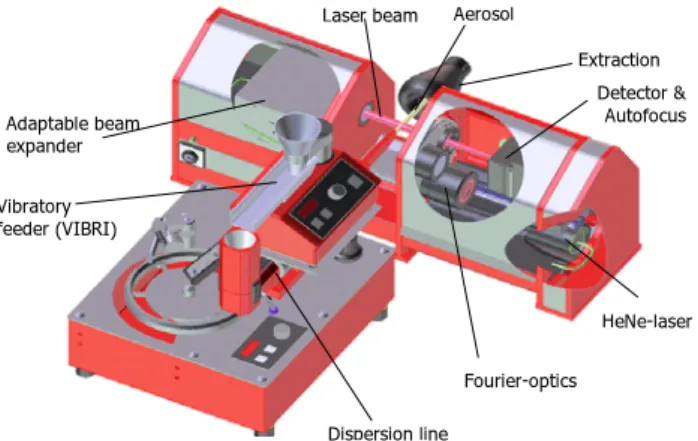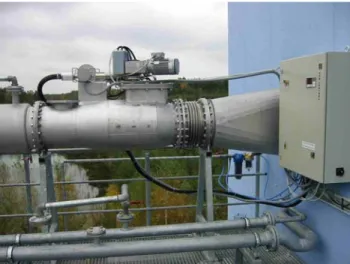© Korean Powder Metallurgy Institute 702 -1. Introduction
Due to its outstanding features such as fast analysis, high resolution, excellent reproducibility, high reliability, and simple operation, laser diffraction over the past 30 years has become the most frequently applied industrial method for particle size analysis from below 1 µm up to the millimetre range. While laser diffraction is the standard method for particle size analysis in laboratories, today more and more in-line installations prove the increasing demand for in-process control. Just recently an instrument for determination of particle shape information has been presented, applying fast image analysis with up to 500 pictures each second. In combination with proven dry powder dispersing devices, statistically relevant information on more than a million particles is available within seconds only.
2. Instruments for off-line laser diffraction To achieve best quality analysis results, the entire laser diffraction system must be perfectly aligned and constant laser intensity has to be guaranteed. The Sympatec HELOS system shown in figure 1 fulfils these requirements being set-up on a robust backbone, free of torsion, its aberration corrected lenses and a state of the art 31 semicircular semiconductor-element-detector that auto aligns to the He-Ne-laser prior to each measurement. Thus the detected diffraction patterns are evaluated on a PC up to 2000 time per second if required.
Adaptable beam expander Vibratory feeder (VIBRI) HeNe-laser Detector & Autofocus Extraction Fourier-optics Dispersion line Aerosol Laser beam
Fig. 1. HeNe-optical bench HELOS for particle size distribution analysis with laser diffraction
In order to allow the interaction between the particles and the HeNe-laser, dispersion units that prepare and transport a perfectly dispersed particle regime into the beam are required. Dry metal powders should be analysed in a dry way and wet metal suspensions should be analysed in a wet way. The dry disperser RODOS applies a combination of shear forces, particle-particle and particle-wall interactions to separate agglomerates reliably even below 1 µm and is well proven and established for metal powders.
3. Instruments for in-& on-line laser diffraction For in- & on-line particle size analysis sampling should be continuous and must be representative. Since most process
2006 POWDER METALLURGY World Congress
A01-07-1
*Invited
Particle Size and Shape Analysis :
The Key to Success in Metal Powder Production
Axel Pankewitz1,a, Yong Jae Park2,b 1
Sympatec GmbH, Am Pulverhaus 1, D-38678 Clausthal-Zellerfeld, Germany
2
Sympatec SYMKOR 113,Imae-Dong, Bundang-Ku, 463-0630 Seongnam-City, Kyonggi-Do, Republic of Korea
a
apankewitz@sympatec.com, bjpark@sympatec.com Abstract
The particle size distribution and shape are among the important parameters for characterisation of quality of metal powders. Specific material properties such as ability to flow, reactivity as well as compressibility and its hardening potentials – hence the most important characteristics of sintered metals - are determined by the size distribution and shape. The correct particle size distribution and particle shape information are the key to best product quality in atomisation processes of aluminium, milling of pure metals and other processes. This paper presents state-of-the-art technology for characterization of particle size distribution and shape.
© Korean Powder Metallurgy Institute 703
-stages are connected by pipes, the sampler – but also the entire disperser and analyser – should ideally be integrated into the process pipe so that only the information about the particle size distribution leaves the pipe. Representative sampling can hardly be realised by a static probe taking out material from a single position in the pipe. Hence a representative sampler has to scan the entire pipe cross-section and feed the sample continuously to the subsequent disperser and analyser.
Figure 2 shows the Sympatec TWISTER & MYTOS laser diffraction on-line particle size analyser integrated into an atomisation process for aluminium powder while figure 3 presents typical process results as trend of characteristic values over time.
Fig. 2. TWISTER & MYTOS installation in a 400mm pipe on top of an aluminium plant
0 2 4 6 8 10 12 14 16 18 20 22 24 26 28 30 32 34 36 38 P a rt ic le s iz e / µ m 0 1 2 3 4 5 6 7 8 9 10 11 12 13 14 15 16 17 18 19 20 O p t. co n cen tr at io n / % 05-07-04 05-07-11 Date and Time
Fig. 3 Trend diagram of characteristic particle size distribution values
4. Instruments for image analysis of size and shape The combination of a high speed CMOS camera, which provides 500 frames/second with a new pulsed light source,
producing flashes of less than 1 nano-second exposure time, allows for sharp cut imaging of high speed particles, as they generate from the cutting edge dry powder disperser RODOS. The QICPIC system is applicable for lab applications while the new PICTOS at- & on-line analyser shown in figure 4 covers process applications.
Both instruments provide simultaneous information of particle size and particle shape on a million or more particles in only a few seconds and covers a particle size range from 1 to 20000 microns. The information about size and shape evaluated with the WINDOX instrument's control and evaluation software suite is permanently stored in more than 20000 size classes in a top speed multi-user client/server structured database. During measurement a video of the particles is created, which is stored together with the data on size and shape, and which is available at any time to apply sophisticated shape characterisation modes on the original data. A Particle Gallery supports an elegant way of finding the famous "needle in a haystack" or to sort the particles according to their size and shape
Fig. 4. PICTOS high speed at-& on-line particle size and shape analyser
4. References
[1] Fraunhofer: Bestimmung des Brechungs-und Farbstreuungsvermögens verschiedener Glasarten, Gilberts Annalyen der Physik 56; 193-226 (1817) [2] Leschonski, S.Roethele, U. Menzel: A special Feeder
for Diffraction Pattern Analyses of Dry Powders; Part. Charact.1; 161-166 (1984)
[3] S. Roethele: In-line Laser Diffraction with Innovative Sampling; 7. Europ. Symposium Particle Character.; 611-624 (1998)

